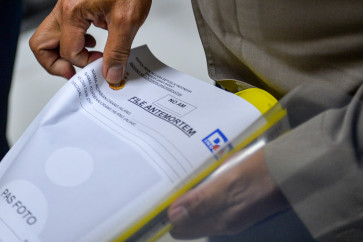Raden Ayu Irawati Kusumorasri: A dedicated Mangkunegaran dancer
JP/Ganug Nugroho AdiRaden Ayu Irawati Kusumorasri from the Mangkunegara Court of Surakarta was already familiar with classical Javanese dance by age 5, for she shares her noble origins with her father, Kanjeng Raden Mas Haryo Sudiyatmo Suryosumanto
Change text size
Gift Premium Articles
to Anyone

J
span class="caption" style="width: 298px;">JP/Ganug Nugroho AdiRaden Ayu Irawati Kusumorasri from the Mangkunegara Court of Surakarta was already familiar with classical Javanese dance by age 5, for she shares her noble origins with her father, Kanjeng Raden Mas Haryo Sudiyatmo Suryosumanto.
At 10 years old, when her peers were engrossed in playing with various traditional toys and games, Irawati was highly skilled in a number of classical dances like Wireng, Gambyong, Srimpi, Langendriyan and other Mangkunegara-style compositions.
“I’m fortunate to have got the classical dance basics directly from the court’s empu [maestros], Bu Bei Mintolaras and Bapak Ngaliman,” said Irawati, who is commonly called Iil.
She said she never thought she would become a faithful classical dancer. As a youth, she regarded the profession of dancers, let alone those of classical Javanese choreography, as promising nothing. She believed the changing times would continue to forget everything traditional and outdated.
“I considered the classical works old-fashioned and thus was overwhelmed by contemporary dances and the latest creations. But the more I learned, the better I liked court dances,” said Irawati, who was born in Surakarta, commonly called Solo, in Central Java on Dec. 12, 1963.
After graduating from high school, Irawati decided to become a professional dancer while studying at 11 March University (UNS) in the department of English literature.
“At the time I thought even if my performances were not to the taste of most people, at least I could
still be a court dancer,” said the woman, who has been a regular Mangkunegara Court performer since the 1980s.
As a Mangkunegara dancer, Irawati is well versed in all the classical dances of the court, notably Srimpi Anglir Mendung, Srimpi Moncar, Mondraswara, Mondrokusumo and Mondrorini, and the heroic dances Menak Koncar and Srikandi Mustokoweni.
“More than just presenting flexible and graceful movements, dancing has to do with grasping the philosophy of the relevant choreography,” she said.
Irawati has also frequently introduced traditional Javanese dance to other countries. From 1986 to 1994 she went to France, Britain, Germany, Japan and Russia as an envoy of art for the Mangkunegara Court.
Outside the court, Irawati has been involved in a long creative process with choreographer Sardono W. Kusumo as a dancer for the Sardono Dance Theater in Japan (1997), and in the performances “Passage through the Gong” (1996), “Opera Diponegoro” (1998) and “Kartini” (2001).
As her entertainment network further expanded, Irawati began her exploration by creating several contemporary compositions like Oncat, Beksan Sekar Ratri and Srimpen Kendi Sekar Putri. She continued on her creative journey along with other artists, ranging from dancers and musicians to actors and dalang (shadow puppeteers).
She also collaborated with the Sahita dance troupe, the Padepokan Lemah Putih art studio and several choreographers in Solo. But, Irawati eventually realized she would still return to classical dance.
“Physically I’ve been experimenting with contemporary pieces. But my heart knows no compromise. Classical dances have been rooted in my dance vocabulary,” she said.
Her first works as a classical choreographer were Oncat and Srimpi Topeng Sumunar in 1994, followed by Operet Timun Mas in 1996, Shinta Obong in 1997, Bedhaya Kakung Si Guse in 2000 and Sesaji Wedatama in 2008. For her post-graduate final assignment at the Indonesian Arts College of Surakarta, she created Sekar Jagad, which amazed her examiners.
“It was an exhausting performance that lasted three hours. Now, I could no longer choreograph such a dance,” said Irawati, who has headed the Semarak Candra Kirana dance studio since 1998.
In her studio, the mother of two not only gives dance instruction but also imparts her knowledge of dance history, legends and philosophical values. And, Irawati is gratified to note that many children and teenagers are joining Semarak Candra Kirana.
“For me, the important thing is to make children and youth love dancing so there will be no generation gap in the preservation of classical dances,” added the woman.
In 2006 and 2007, Irawati also managed the Indonesia Art and Culture Scholarship (IACS) program of the Foreign Affairs Ministry.
The program provides Javanese art and culture training to foreign participants.
The youngest child of Sudiyatmo Suryosumanto and Sri Wulan has also organized major events. One of them was the Solo International Performing Art (SIPA) event, an annual art event held in Solo since 2008.
This year, SIPA took place from July 1 to 3 at the Mangkunegara Court and involved hundreds of artists from different countries.
“I want SIPA to grow into a prestigious arena. Though not necessarily big, it should be familiar to many nations. It’s like the remarkable Cannes Film Festival in France,” said the dancer, who last year performed classical Javanese dances in the Netherlands.
In 2011, she said SIPA presented masks as its theme. “They’re meant to respond to present conditions, which are obscure and lack transparency. This country is again unwilling to be open. It’s like that, more or less. The second reason is the art of masks is found on five continents, so it is universal in nature,” said Irawati, who was Putri Solo 1986.
Apart from its theme, SIPA is a meeting forum for various arts and cultures in the domain of performing art, according to Irawati. Foreign delegates from Korea, Mexico, Romania, India, Malaysia and the Netherlands joined the event.
Made more famous by previous SIPA festivals and other activities, Irawati is still determined to keep dancing. “I decided to be a dancer so I won’t stop dancing. I’m following in the footsteps of Sawitri [a masked dance maestro from Cirebon], vowing to dance till death. She’s a great artist,” said Irawati.









